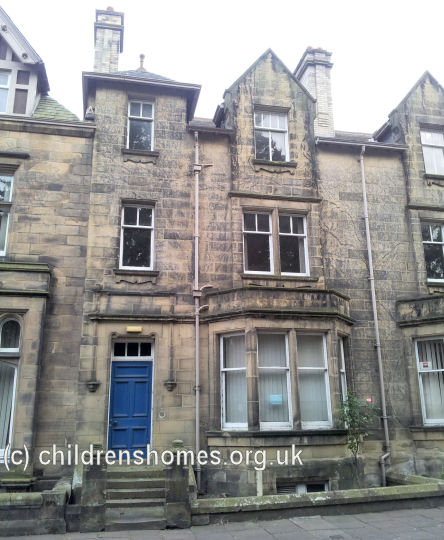Carlisle Council Homes
In 1930, the Boards of Guardians, who had administered the poor relief system in England and Wales since 1834, were abolished and their responsibilities were taken over by county and county borough councils. Each council set up a Public Assistance Committee to oversee its new duties, which included the operation of the various children's establishments previously run by the poor law unions in each area. The Carlisle Council took over the Brackenber Lodge children's home at Shap, formerly run by the Carlisle Union. The home could accommodate up to 63 children.
By 1943, the council had opened a replacemnt home in Carlisle in a property known as Petteril Bank, on Petteril Bank Road, Harraby, where 24 children could be housed.
Following the passing of the 1948 Children Act, councils were required to provide care services for all needy children in their area, especially those who lacked a normal family home. In common with other local authorities, the council established a new Children's Committee, whose responsibilities had previously been spread across separate Health, Education and Public Assistance Committees. The Committee appears not to have retained Petteril Bank (now home to the Carlisle Register Office) but instead opened a new home at Aglionby Grange, Holme Lane, Scotby.
The 1948 Act had recommended that where children needed to be in residential care, they should be in 'family group' homes, which ideally accommodated no more than eight children, or twelve at most. The council's first move in this direction came in around 1953 with the opening of a home for nine children at 16 Portland Square, Carlisle. At around the same time, a further home was opend in a the large premises of Carlisle House, Townhead Road, Dalston.

Former Carlisle Council children's home, Portland Square, 2014.
© Peter Higginbotham.
In around 1961, the Dalston home was replaced family group homes at 1 Meade Road, Harraby, and 30 Raiselands Road, Morton, Carlisle, both located on new council housing estates and each housing nine children. A further family group home was opened in around 1970 at 54 Westrigg Road, Morton.
As part of the local government reorganisation that took place in 1974, Carlisle's social services provision, including its children's residential care, was taken over by the new Cumbria County Council.
Children's establishments run at some time in their history by Carlisle Council.
- Family Group Home, 1 Meade Road, Harraby, Carlisle
- 16 Portland Square, Carlisle
- 30 Raiselands Road, Morton, Carlisle
- 54 Westrigg Road, Morton, Carlisle
- Petteril Bank House, Petteril Bank Road, Carlisle
- Carlisle House, Townhead Road, Dalston
- Aglionby Grange, Holme Lane, Scotby
- Carlisle Union/Council Cottage Homes, Brackenber Lodge, Home Lane, Shap*
* indicates link to pages on www.workhouses.org.uk.
Records
The involvement of local authorities in the running of children's homes dates from 1930, when they took over the running of the poor relief system previously administered by Boards of Guardians. Surviving records for council-run children's homes may be held in each council's own internal archives. Prior to 1991, however, when a legal requirement was introduced for councils to retain records of children leaving their care, the survival of such records is very variable. Contact details for local authorities in the UK can be found on the website of the Care Leavers Association (CLA). The CLA also provides guidance on accessing childhood care files, which are normally only open to the individuals they relate to.
Locating local authority records has been complicated by the various local government reorganizations that have taken place in recent times, such as the abolition of the London County Council in 1965, and the major nationwide restructuring in 1974 in which many administrative areas were created, amended or eliminated.
Older records may sometimes be placed with the relevant county or borough record office. Many of these repositories have online catalogues of their holdings and also contribute to the National Archives' Discovery database. Note that records containing personal data usually have access closed for a period of fifty years or more.
Older material relating to Carlisle Council homes may exist at:
- Carlisle Archive Centre, Lady Gillford's House, Petteril Bank Road, Carlisle CA1 3AJ.
Some records relating to council-run homes, for example inspection reports (though not resident lists etc.), are held by The National Archives (TNA). A closure period may apply to these records.
Bibliography
- Higginbotham, Peter Children's Homes: A History of Institutional Care for Britain's Young (2017, Pen & Sword)
- Urquhart, Gloria (2020) Nobody's Child: The True Story of Growing up in a Yorkshire Children's Home
- Cooke, Allan Institutionalized in a Children's Home: Skellow Hall 1950-1963 — a true story of a child and children in a home (2012, Authorhouse)
- Cummings, Les Forgotten: The Heartrending Story of Life in a Children's Home
- Limbrick, Gudrun The Children of the Homes: a century of Erdington Cottage Homes
Except where indicated, this page () © Peter Higginbotham. Contents may not be reproduced without permission.


